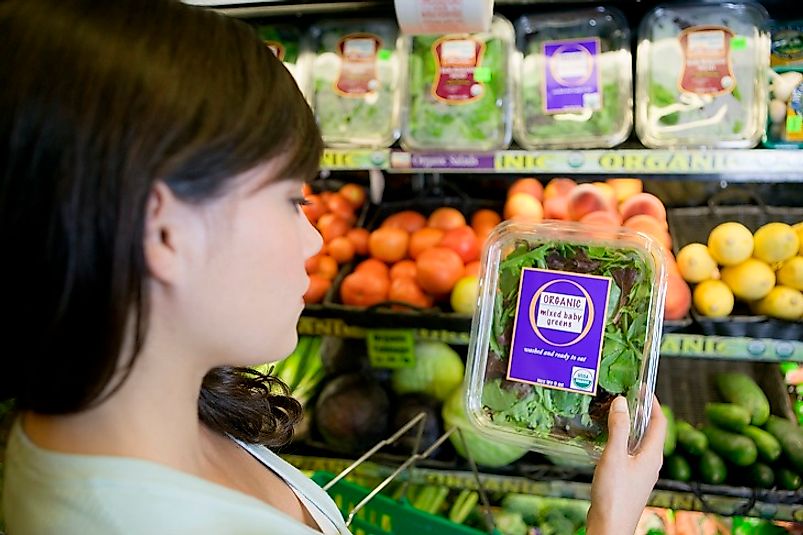Global Markets For Organic Farm Products

Organic farming produces crops and livestock without the use of synthetic chemical fertilizers and pesticides, antibiotics, or genetically modified organisms. It is also aimed at developing a holistic system of production that considers the health of the entire ecosystem including people, according to the Canadian Organic Standards.
5. Most Widely Traded Organic Commodities
The most important organic commodities today are cereals, especially rice. Also important are such organic cereals as wheat, barley, oats, maize, rye, and triticale, temperate fruits (oranges, lemons, limes, grape-fruits, pomelos, tangerines, apple, apricots, pears, plums and peaches), wine, tropical and subtropical fruits (mangoes, avocados and bananas), vegetables (fresh peas and beans, leafy salads, and fruit vegetables), coffee, tea, cacao, herbs and spices, and dried fruits and nuts. Among fibers, cotton has the largest share in organic production.
4. Top Organic Farm Goods Source Countries
The top producers of organic cereals are India, China, the United States, Canada, Italy, Austria, Sweden, Estonia and Bolivia. Organic oil-seeds come from China, India, Kazakhstan, the United States, Ukraine, and Canada. Dried pulses are produced in Sweden, France, Spain, Canada, Italy, Lithuania and Germany.
Major organic citrus producers are Italy, Mexico, and China. Temperate fruits come from Poland, China, US, Italy, Turkey and France. Tropical Fruits come from Mexico, Dominican Republic, China and Turkey. 80% of grapes come from Europe, Spain, Italy and France.
Organic vegetables are mainly produced in the United States, Mexico, Poland, and Italy. 80% of organic olives are produced in three countries, namely Spain and Italy in Europe and Tunisia in North Africa.
The Latin American countries of Dominican Republic, Peru and Mexico produce 88% of the organic cocoa globally, with the countries of Ecuador, Ghana, and Uganda among the other important producers. Coffee comes from Nepal, East Timor, Bolivia, Mexico, Ethiopia, and Peru. China, India and Sri Lanka are the main producers of organic tea, with 70% of tea grown in traditional organic cultivation in China.
Organic cotton is produced in twenty countries, and the major contributors to such are India, Syria, China, Turkey, the United States, Tanzania, Egypt, and Mali.
3. Largest Markets for Organic Farm Goods
According to the 2016 report by Organics International, the United States alone accounts for 43% of the global organic retail sales, and the European Union's 28 countries collectively account for another 38%. The ten countries with the largest shares of organic markets, in descending rank, are the United States of America, Germany, France, China, Canada, the United Kingdom, Italy, Switzerland, Sweden, and Austria.
2. Projected Regional and Global Growth in the Future of Organic Markets
Global demand for organic food and beverages had reached $80 billion annually by 2014. In US alone organic food sales doubled to $36 billion in 2014 in seven years, according to the Organic Trade Association. Fruits and vegetables were the main commodities, followed by dairy feed. In the other major region Europe, demand for organic is also rising steeply. Sales doubled in ten years to $26.83 billion in 2014, with an increase of 7.6% from 2103 to 2014. Most of the producers who are developing countries unfortunately consuming little of their organic commodities, since they are mostly slated for export.
1. International Market Regulations
Organics International, or the International Federation of Organic Agriculture Movements (IFOAM) as it was known until 2015, is the only global umbrella organization for organic agriculture in the world. In 2016, it boasts of having more than 800 members from 100 countries. It develops organic standards, and promotes organic cultivation and trade. It also has its own certification program.
There is no common global standards for certifying organic commodities. Certification is necessary to assure consumers of this essentially global market of quality and prevent fraud, while producers benefit from better prices and access to markets. In US, Europe, Japan and Canada, the label 'organic' is available only on certification. The US Agriculture Department recognizes 80 certifying agents, of which 48 are from the US and follow USDA standards, and the rest follow standards in their respective countries. The European Union (EU) regulations control farming, production, trade and labeling of organic products. Non-food products can have their own certification programs, such as those for organic fibers which are certified to sourcing standards by Organic Exchange (OE) Blended or OE 100 standard, and Global Organic Textile Standard (GOTS).











